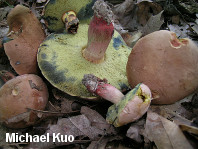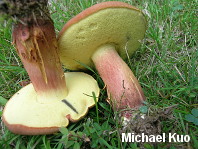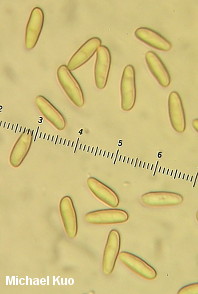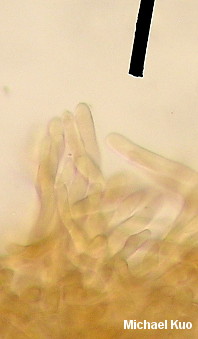| Major Groups > Boletes > "Boletus" | Red-Capped, Blue Staining > Boletus pallidoroseus |

|
Boletus pallidoroseus [ Basidiomycota > Boletales > Boletaceae > Boletus . . . ] by Michael Kuo Like a cross between Boletus bicolor and Boletus pseudosensibilis, this fairly recently described species features pink colors, blue bruising, and a cap that flashes green with a drop of ammonia. The late Ernst Both originally described Boletus pallidoroseus from New York (1998), but the species has since been fairly widely documented east of the Great Plains. Description: Ecology: Mycorrhizal with hardwoods (perhaps exclusively with oaks); growing alone, scattered, or gregariously; summer and fall; probably widely distributed east of the Rocky Mountains. The illustrated and described collections are from Illinois. Cap: 5-15 cm; convex, becoming broadly convex or almost flat; dry; bald or, when young, very finely velvety; rose pink when young, but quickly fading to pinkish tan. Pore Surface: Yellow at first, becoming olive yellow; bruising blue promptly, then slowly brown; pores circular to angular, 1-3 per mm; tubes shallow, to 10 mm deep. Stem: 4-7 cm long; 2-3 cm thick; more or less equal, with a tapered base; not reticulate, or faintly so at the apex; fairly bald; yellowish above; rose pink to deep pinkish red below, becoming pinkish tan; often bruising blue, then slowly brownish; basal mycelium whitish to pale yellow. Flesh: White to yellowish in the cap; yellow in the stem; bluing above the tubes and in the stem when sliced. Odor and Taste: Odor like beef bouillon; taste not distinctive. Chemical Reactions: Ammonia flashing blue to green or blue-green on cap surface, then resolving to gray; orangish on flesh. KOH reddish to yellowish orange on cap surface; orangish on flesh. Iron salts olive to gray or negative on cap surface; gray or negative on flesh. Spore Print: Olive brown. Microscopic Features: Spores 9-12 x 3.5-4.5 µ; subfusiform; smooth; yellowish to yellow in KOH. Hymenial cystidia fusoid-ventricose to fusoid or subclavate; golden in KOH; to about REFERENCES: Both, 1998. (Both, 1998; Bessette, Roody & Bessette, 2000.) Herb. Kuo 08020401, 09070702. This site contains no information about the edibility or toxicity of mushrooms. |
© MushroomExpert.Com |
|
Cite this page as: Kuo, M. (2015, January). Boletus pallidoroseus. Retrieved from the MushroomExpert.Com Web site: http://www.mushroomexpert.com/boletus_pallidoroseus.html |



